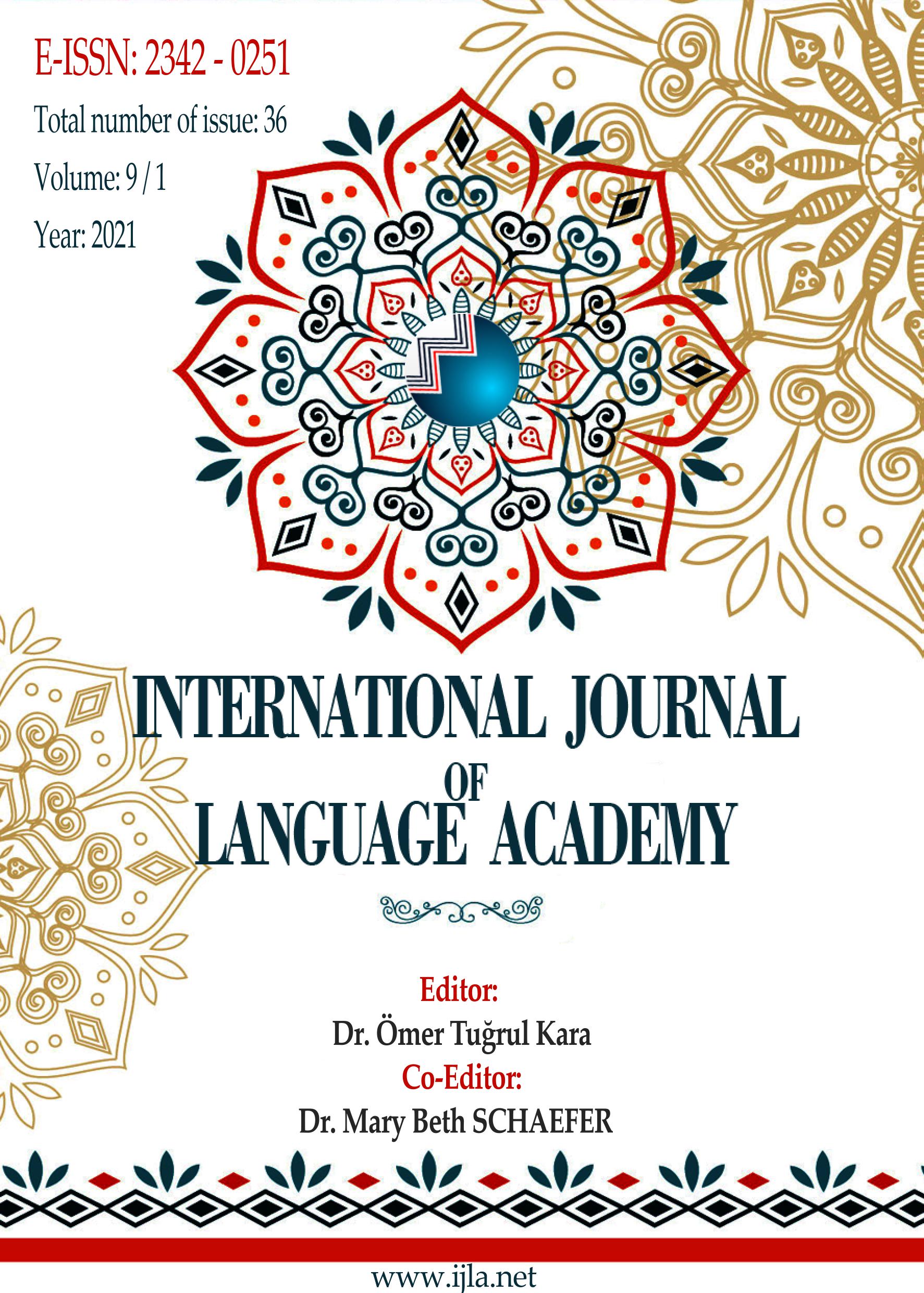Author :
Abstract
Eğitim sisteminin her kademesinde olduğu gibi ortaöğretim kademesinde de öğrenciler, belirli bir sınava tabî tutularak ilgi, istek ve yetenekleri doğrultusunda üst kademeye yerleştirilirler. 2018-2019 öğretim yılında uygulanmaya başlanan Liselere Geçiş Sistemi (LGS) çoktan seçmeli sorular çerçevesinde gerçekleştirilen iki oturumlu sınav sistemidir. Çalışma kapsamında her öğretim yılı sonunda uygulanan ortaokul kazanım ve becerilerini temel dersler çerçevesinde ölçülmesini amaçlayan LGS bünyesinde yer alan Türkçe sorularının okunabilirlik düzeyleri incelenmiştir. Okunabilirlik kavramı soru, paragraf ya da metinlerin kolay ya da güç anlaşılma durumu ile ilgili fikir veren nicel ifadelerden oluşmakta ve bu nicel veriler sayesinde metnin sınıflandırılması, yorumlanması ve çıkarımlarda bulunması sağlanmaktadır. Sorulardaki okunabilirlik seviyelerini belirlemek amaçlı Ateşman’ın (1997) Flesch'in Okuma Kolaylığı Formülünden Türkçeye uyarlanan kelime ve cümle uzunluğuna dayalı formülü ve Çetinkaya-Uzun (2010) formülü kullanılmıştır. LGS sorularının incelenmesi amacıyla doküman inceleme yöntemine başvurulmuştur. Sınav kapsamında Türkçe bölümü 20 sorudan oluşmaktadır. Verilen analizinde betimsel istatistikten yararlanılmıştır. Çalışmanın sonucuna göre 2020-LGS Türkçe sorularının Ateşman Formülüne göre okunabilirlik düzeyi 2 sorunun (%10) kolay, 12 sorunun (%60) orta, 5 sorunun (%25) zor, 1 sorunun da (%5) çok zor güçlükte okunabilirliği olduğu; Çetinkaya-Uzun Formülüne göre ise 9 sorunun (%45) Eğitsel Okuma Düzeyinde, 11 sorunun da Engelli Okuma Düzeyinde olduğu tespit edilmiştir. Ortalama Sözcük Uzunluğu (OSU) 2,80; Ortalama Tümce Uzunluğu (OTU) 11,12 olarak hesaplanmıştır.
Keywords
Abstract
As in all levels of the education system, students at the secondary education level are placed in the upper level in line with their interests, wishes, and abilities by being subjected to a specific examination. The High School Transition System (LGS), which was implemented in the 2018-2019 academic year, is a two-session exam system conducted within the framework of multiple-choice questions. Within the study's scope, the readability levels of Turkish questions included in the LGS, which aims to measure the secondary school achievements and skills applied at the end of each academic year, within the framework of introductory courses, were examined. The concept of readability consists of questions, paragraphs, or quantitative information that give an idea about the easy or difficult understanding of the texts, and thanks to these quantitative data, the text is classified, interpreted, and thus can be deduced from. To determine the readability levels in the questions, Ateşman's (1997) formula, which is based on word and sentence length and adapted to Turkish from Flesch's Ease of Reading Formula and Çetinkaya-Uzun (2010) formula were used. To study the LGS questions, the document review method was used. Within the scope of the exam, the Turkish section consists of 20 questions. Descriptive statistics were used in the analysis. According to the results of the study, the readability level of 2020-LGS Turkish questions according to Ateşman Formula is that 2 questions (10%) are easy, 12 questions (60%) are of medium-level, 5 questions (25%) are difficult, and 1 question (5%) is very difficult to read; According to the Çetinkaya-Uzun Formula, 9 questions (45%) were found to be Educational Reading Level and 11 questions to be Upper Reading Level. According to the data obtained from the 2020 LGS Turkish test: Average Word Length (AWL) 2.80; Average Sentence Length (ASL) was calculated as 11.12.
Keywords
- Ateşman, E. (1997). Türkçede okunabilirliğin ölçülmesi. Dil Dergisi, 58, 71-74.
- Bağcı, H. ve Ünal, Y. (2013). İlköğretim 8. sınıf Türkçe ders kitaplarındaki metinlerin okunabilirlik düzeyi. Ana Dili Eğitimi Dergisi, 1(3), 12-28.
- Baki, Y. (2019). Türkçe dersi 8. sınıf kitabındaki metinlerin okunabilirliği. Dil Eğitimi ve Araştırmaları Dergisi, 5(1), 30-46. DOI: 10.31464/jlere.528298
- Çiftçi, Ö., Çeçen, M. A. ve Melanlıoğlu, D. (2007). Altıncı sınıf Türkçe ders kitaplarındaki metinlerin okunabilirlik açısından değerlendirilmesi, Elektronik Sosyal Bilimler Dergisi, 22, 206–219.
- Göğüş, B. (1978). Orta dereceli okullarımızda Türkçe ve yazın eğitimi. Ankara: Gül Yayınevi.
- Gündoğdu, K., Kızıltaş, E. ve Çimen, N. (2010). Seviye belirleme sınavına (SBS) ilişkin öğrenci ve öğretmen görüşleri (Erzurum il örneği). İlköğretim Online, 9(1), 316-330.
- Hitchcock G. ve Hughes D. (1995). Researchandthe teacher: a qualitative introduction to school based research (2nd Ed.), London: Routledge.
- Hürriyet (2017). TEOG Kaldırılıyor, Eğitimciler Yorumladı.14.07.2019 tarihindehttp://www.hurriyet.com.tr/son-dakika-teogkaldiriliyor-egitimcileryorumladi-40580681 adresinden erişildi
- Kızkapan, O. ve Nacaroğlu, O. (2019). Fen bilimleri öğretmenlerinin merkezi sınavlara (Lgs) ilişkin görüşleri. Nevşehir Hacı Bektaş Veli Üniversitesi SBE Dergisi, 9(2), 701-719.
- Kösecioğulları U., Sarıçam i. ve Topçuoğlu Ünal F. (2020). 2019 - LGS Türkçe sorularının okunabilirlik açısından incelenmesi. International Journal of LanguagesEducation (7/4) 327-341 DOI : 10.29228/ijlet.44064
- MEB, (2019). 2019 yılı ortaöğretim kurumlarına ilişkin merkezi sınav. Eğitim Analiz ve Değerlendirme Raporları Serisi, No: 7. Ankara: MEB.
- MEB(2020). Ortaöğretim Kurumlarına İlişkin Merkezi Sınav, 2023 Eğitim Vizyonu.21.02.2021 tarihinde https://orgm.meb.gov.tr/dosyalar/progindex.html adresinden erşilmiştir.
- Mizraoğlu, V. ve Akın, E. (2015). 5 Sınıf Türkçe ders kitabındaki metinlerin okunabilirliği üzerine bir inceleme.Siirt Üniversitesi Sosyal Bilimler Enstitüsü Dergisi. (4)167-176.
- Özkan, Y. Ö., Güvendir, M. A., ve Satıcı, D. K. (2016). Temel eğitimden ortaöğretime geçiş (TEOG) sınavının uygulama koşullarına ilişkin öğrenci görüşleri. Eğitimde Kuram ve Uygulama, 12(6), 1160-1180.
- Şaki̇roğlu, Y. (2020). Ortaokul Türkçe ders kitaplarındaki öykülerin kelime–cümle uzunlukları ve okunabilirlik düzeyleri üzerine bir inceleme. Anemon Muş Alparslan Üniversitesi Sosyal Bilimler Dergisi, 8(6) , 1827-1834.
- Yıldırım, A. ve Şimşek, H. (2011). Sosyal bilimlerde nitel araştırma yöntemleri. Ankara: Seçkin Yayıncılık.
